Learn about Udemy instructor earnings and whether you should sell your own content on the platform.
Key takeaways
- Average Udemy instructors earn only $3,306 per year according to independent studies.
- Instructors keep 97% of sales from referral links but only 37% from marketplace discoveries.
- The top 1% of Udemy instructors capture over half of all platform earnings.
- Only instructors in the top 1% make $50,000 or more annually on Udemy.
- Whop offers better revenue sharing, taking only 2.7% versus Udemy's 63% marketplace fee.
If you’ve looked at different ways of making money on the internet, it’s a very safe bet that you’ll have heard or seen mention of Udemy. The platform is extremely well-known and used by educators and influencers alike, so it’s worth investigating.
So, how much do Udemy instructors really make, and is joining Udemy to sell your own content a good idea? We’ve got the full scoop, so read on.
What Can You Sell With Udemy?
Udemy is, first and foremost, an online course platform. As such, Udemy instructors are in the business of selling their online courses, although the contents of said courses are extremely varied—you can find courses on Udemy covering just about any imaginable topic.
Importantly, Udemy is considered an excellent learning platform by businesses as well as individual learners. For this reason, you’ll find a lot of courses that appeal to a company’s HR training and development budget. Courses covering skills that help in the workplace are abundant across Udemy, from technical skills such as programming or accounting all the way to more general ones like productivity.
Udemy has well over 10,000 enterprise customers (those are the businesses buying courses for entire teams at a time) and around 50 million learners choosing from close to 200,000 courses on the platform.
Not every course on Udemy is a paid product, either. Many instructors offer free courses as a way of building an audience and giving them a taste of what’s to be had behind the premium product.
How Do Instructor Earnings Work on Udemy?
If you want to make money on Udemy, you have two main options. They are to:
- Become a Premium Instructor.
- Join Udemy for Business.
As you might imagine, becoming a Premium Instructor means gaining the right to actually sell courses on the platform. To gain this status, you’ll simply have to start building a course, then enter a description of your expertise, write a bio, and upload a profile picture. If these entries meet Udemy’s standards, you’ll be approved in 2 business days.
Premium Instructor Earnings
Once Udemy grants you Premium Instructor status, you’re free to sell courses on the platform. Heads up, though, there’s a catch—your Udemy referral link is going to be extremely important. You’ll get it once you go Premium, and using it makes a huge difference.
So, here’s how it works. If students discover you or your course on the Udemy marketplace and sign up for your paid courses there, you’re only going to get 37% of the sale value. If you promote your course using your channels and get people to sign up with your referral link? You can keep 97% of the sale.
This is obviously a massive factor in instructor earnings, and Udemy really puts the onus on the instructor to do all of the marketing and promotion for their courses—they’re gaining platform customers by using you and their other instructors as a marketing tool.
Udemy for Business Earnings
The second avenue through which you can earn on Udemy is through Udemy for Business. This one’s a little trickier to get set up with because there’s no real way to take the initiative—it’s Udemy who’ll reach out to you about this one. All you can do is ensure that your courses are to as high a standard as possible and you’ll have a chance of being picked out. Getting your students to rate and review you positively won’t hurt either.
Udemy for Business changes the model up a bit, too. Companies subscribe to the service, letting their employees gain access to a wide variety of courses. These subscription funds then go into a pool. The lion’s share of this pool goes to Udemy, but 25% is shared among instructors whose courses are consumed by Udemy for Business subscribers.
That’s pretty complicated, so let’s simplify it with an example using made-up numbers. If companies pay $4,000 into Udemy for Business, $1,000 is available to be shared between instructors. Now, if your courses make up 20% of the courses (in terms of watch time) consumed by the subscribers, you’ll pick up 20% of that $1,000, or $200.
Realistically, of course, the Udemy for Business pool is a lot bigger—and no matter how much of a hit your courses are, they’re only going to make up a very small fraction of the courses that are consumed.
As you can see, the revenue share model is complex and there are many factors to take into account, which is why it is not easy to find a clear answer on how much you can earn with Udemy. That's why we have read into a range of different instructors and how much they each earn.
How Much Money Do Udemy Instructors Make?
According to one independent study, instructors on Udemy make an average of $3,306 per year, and the top 1% of Udemy instructors take away over half of the total platform earnings. Furthermore, only the top 1% make 50k or more per year on the platform, with 75% of instructors making less than $1,000 a year.
However, the amount of money that Udemy Instructors make can vary quite dramatically, and it all depends on whether or not they’ve been able to establish an audience. As we’ve established, being able to build your own community and market to people with your referral link can make all the difference when it comes to earnings.
Starting instructors may not have much of an audience at all, and just as with any form of content creation, making that first sale can be a pretty big milestone. There are plenty of instructors on Udemy who aren’t earning yet or only taking in a couple of hundred dollars a month as they try to get going. Udemy is very much a side hustle for a lot of instructors.
On the other end of the spectrum, some of Udemy’s star creators are raking in literal millions from the platform. This image says it all:

That’s Phil Ebiner, and he was featured in an article by Forbes about how his earnings on Udemy were skyrocketing—and that’s after pulling in $500,000 the previous year. According to the Udemy CEO at the time, Gregg Coccari, Ebiner was among several hundred Udemy instructors making six figures a year back in 2020.
5 Examples of Udemy Creator Earnings
Let’s look at a few examples of Udemy creators so that you can decide for yourself whether Udemy offers the sort of earning potential you’re after.
Joe Parys
Joe Parys is an example of Udemy’s 1%, but that probably isn’t going to be a surprise since he’s got just about as many subscribers on his YouTube channel as dollars he has made on Udemy—that’s a huge advantage in terms of an audience to whom he could sell courses without having to rely on the Udemy marketplace at all.
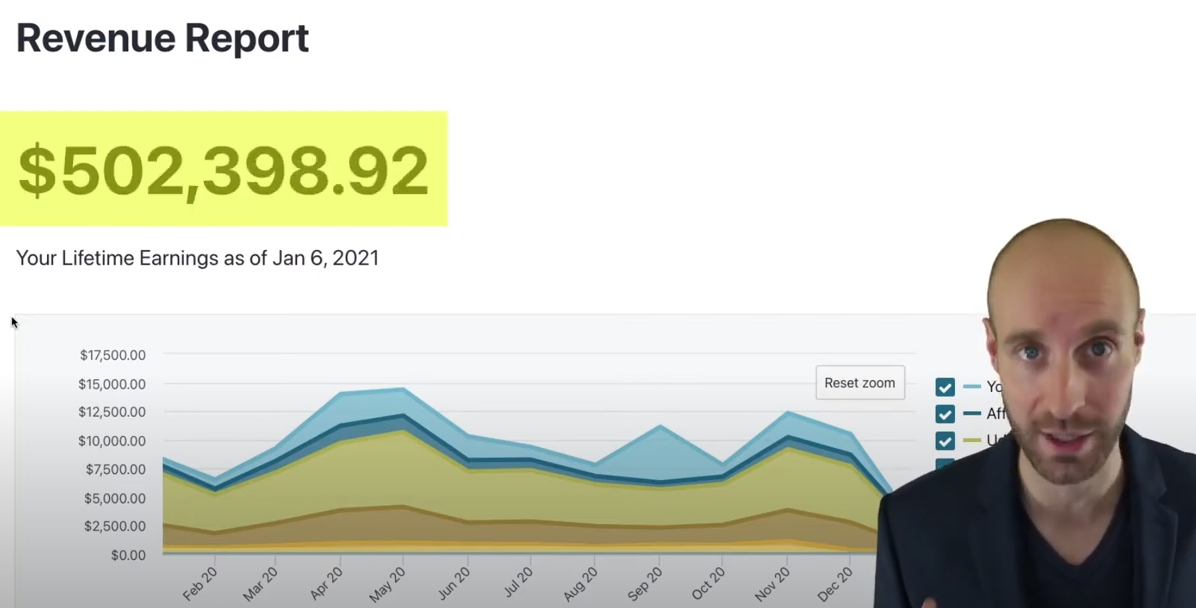
Even so, Joe has made his revenue reports public from back when he sold courses on Udemy, and it took a few months to reach that critical mass. Still, he went from picking up a hundred dollars a month to over $11,000 within nine months, which is a very fair effort, and he did put the work in, selling 90+ courses including collabs with other influencers.
Joseph Okon
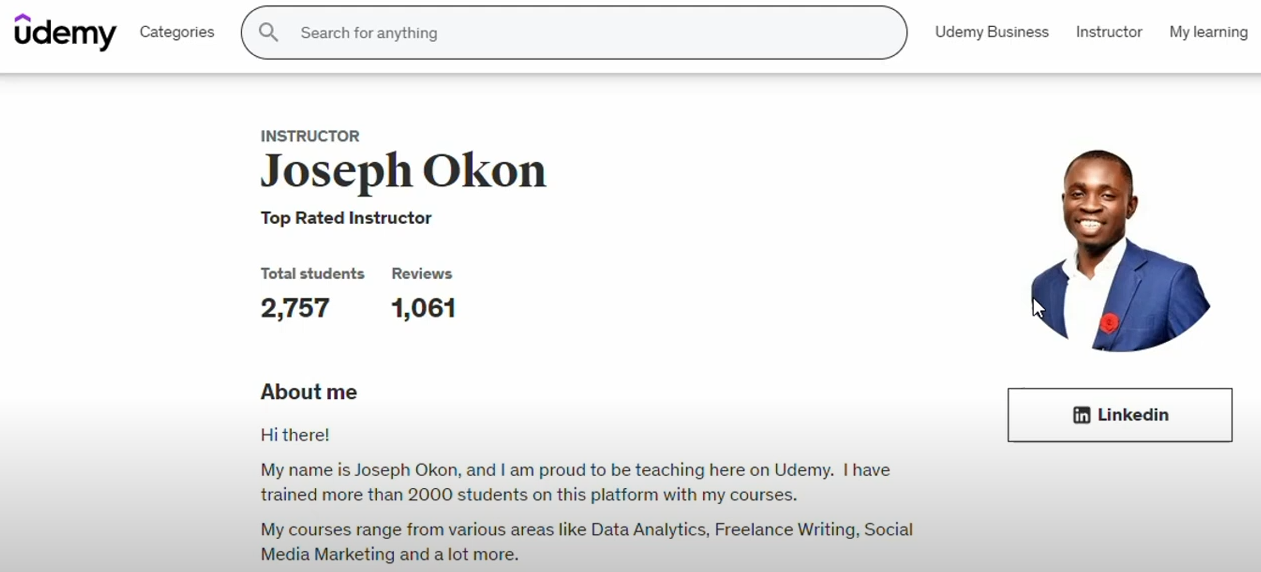
Joseph Okon is a full-time Udemy instructor based in Nigeria, and as of earlier this year, he was closing in on 2,800 students. That’s a lot of sales, and as the above image shows, he’s got courses covering a variety of topics.
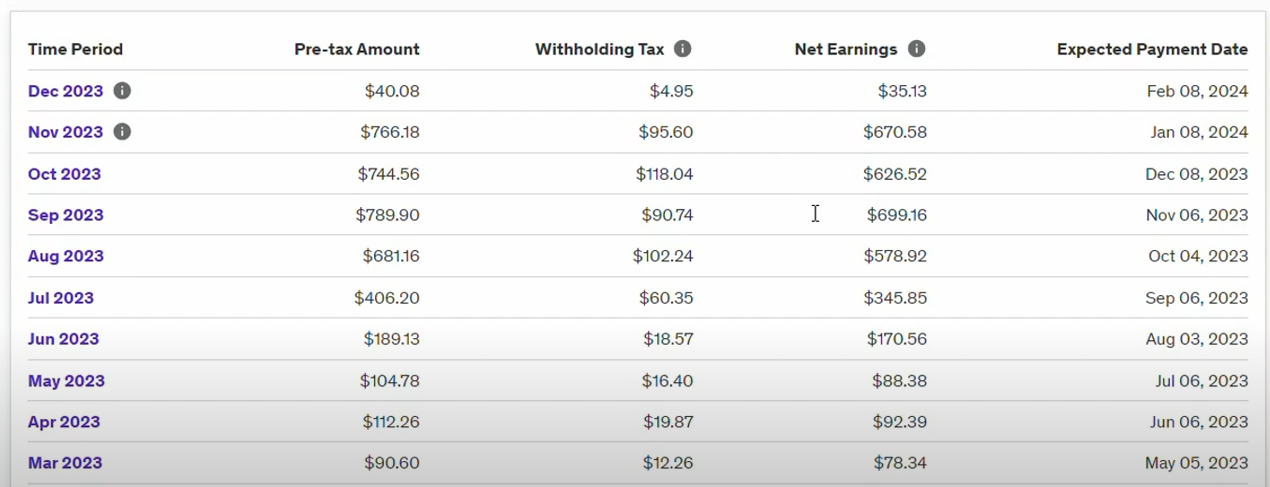
As you can see, Okon earns a relatively consistent sum from Udemy, and while it’s not really anything to write home about if you live in the US or Europe, it’s enough to make a living if you’re in a country where the cost of living is a lot lower. From December ‘22 to December ‘23, Okon took home just over $4,300 with 12 courses up for sale.
Christina’s Side Hustles
Christina Ngm, who runs a YouTube channel and explores different means of online money-making on behalf of her audience, also gave Udemy a shot. You’d expect someone with a great understanding of ecommerce and online side gigs to master Udemy quite quickly, but these were her results across an entire year of selling courses on Udemy:

Granted, this was back in 2022 and she had fewer subscribers back then, but it just goes to show that the stats really do play out—if you’re not in the 1% of Udemy creators, you’re just not going to make very much from the platform.
Jutta Martin
Udemy is available in 75+ languages, so it’s worth taking a look at whether it’s possible to make money on the platform if English isn’t your number one choice. This is the earnings report of Jutta Martin, who sold courses for five months in German:
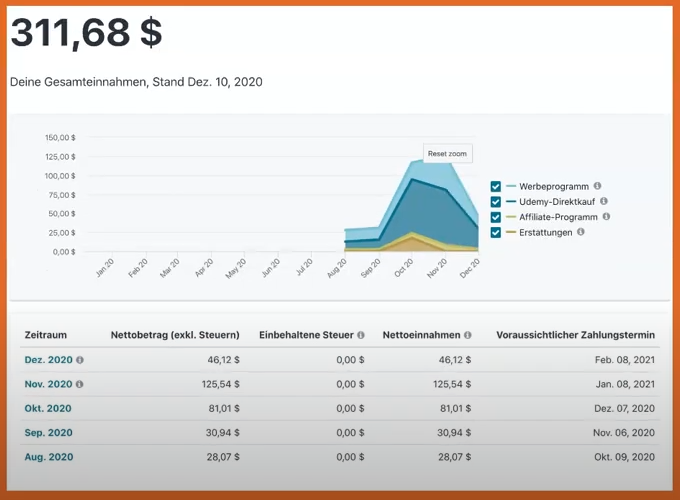
As you can see, it’s certainly possible to sell courses in whatever language you choose, but the road to four-, five-, or even six-digit earnings isn’t particularly well traveled. Not many Udemy creators go beyond the numbers you’re seeing here without a whole lot of hard graft or a good eye for course demand and marketing.
Quora users
Quora is a fun site for getting quick answers, and the top answer on Udemy’s revenue potential (upvoted by other Udemy creators) is by Dane Bezmane. It doesn’t make for very pleasant reading, at least if you’re on Team Udemy:
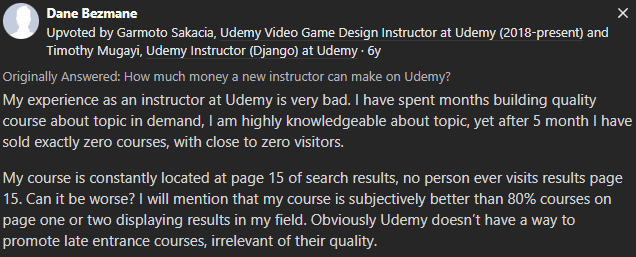
Bezmane has over 500k content views on Quora, so he’s not just a single disillusioned random person who gave Udemy a try one afternoon and didn’t like it. That being said, there’s plenty of positivity in the wild about Udemy too. Just scrolling down on that same Quora thread, we’ve got this one by Matt Bernstein:
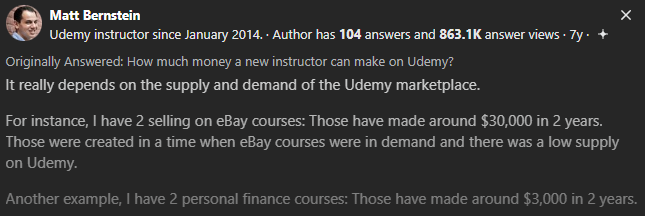
Supply and demand is a Udemy theme that a lot of successful creators on the platform talk about. It’s usually the ones who can spot an opening and create courses to hit underserved or new niches who do best—like with other platforms, it’s more about learning how the platform and its algorithms work than creating quality content.
Is Udemy Worth It?
Whether or not Udemy is worth it depends on you and what your expectations and skillset are. If you’re a dab hand at spotting trends and can get ahead of the times, you could success on Udemy by offering courses in niches that are about to boom and where nobody else is operating.
The other way to make Udemy work is to leverage an existing audience, but again there’s an argument that Udemy doesn’t give you anything more than other course platforms. It’s a huge segment of ecommerce for a reason, and there are more great online course platforms out there than you might think—and many are better than Udemy.
The bottom line is that even if you are successful, you may only get to keep 37% of your sales revenue - or even just a share of 25% of the revenue.
A More Profitable Option: Selling Online Courses With Whop
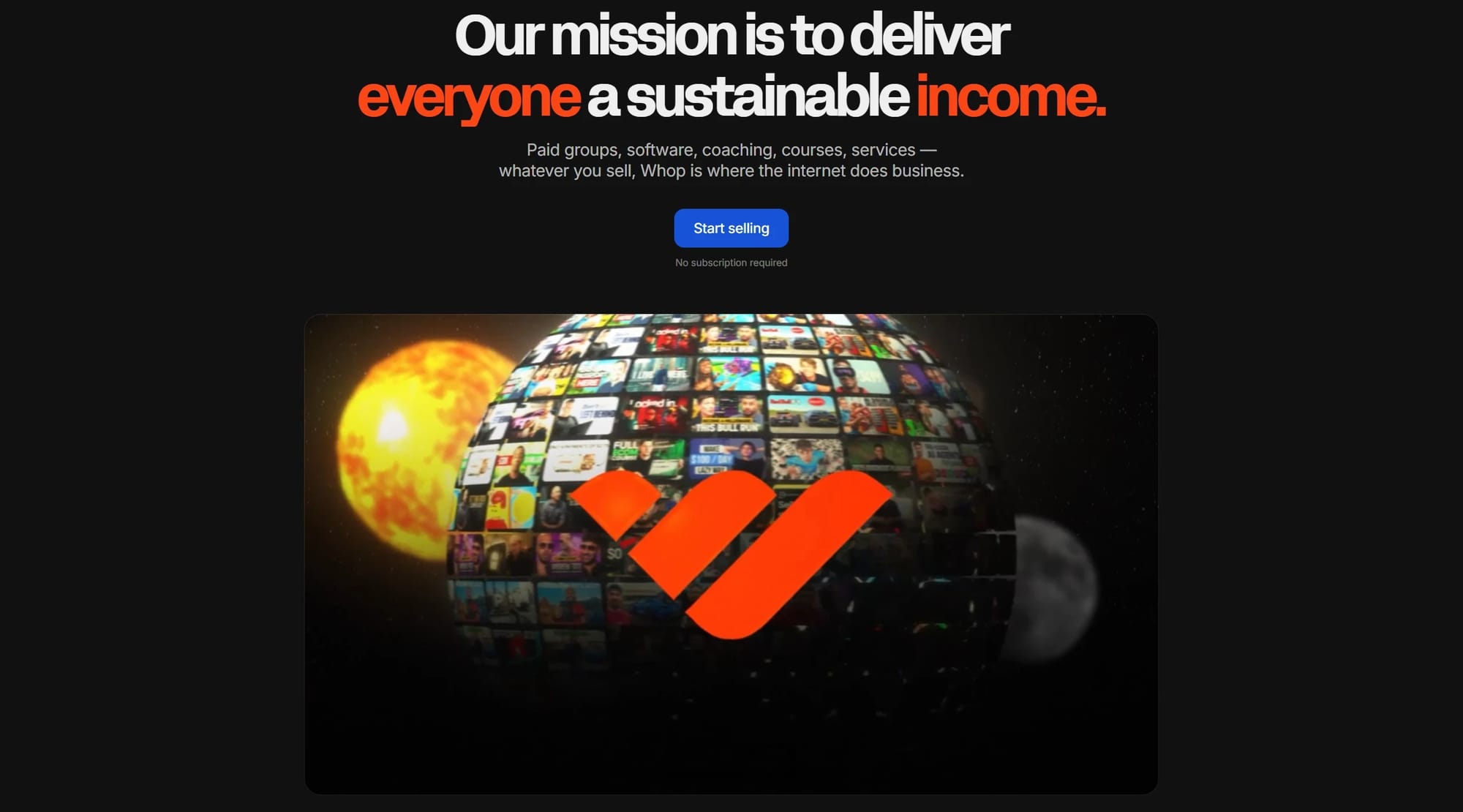
If you want to make money online and think courses are the way to go, Udemy isn’t the only option out there. Yes it is one of the most established names, but as we’ve shown, you’ve got to have a huge audience or an almost supernatural instinct for trends if you want to make it big on Udemy. If you’ve got neither, Udemy is going to be a side hustle at best and a source of little more than pocket change as the platform keeps between 3 and 75% of your revenue.
We think Whop is an option that’s well worth considering if you want to sell online courses. It features a robust course builder that can more than compete with Udemy, and ecommerce is really easy with Whop. You can start earning within a few minutes of signing up, and there’s no need to wait for approval to become a Premium Instructor. Just sign up for a Whop account, add some basic info to your digital store page, and upload or create your premium course.
Plus, Whop’s revenue model is much more simple than Udemy’s. You don’t even need a referral code—if your students go straight to your page and make a purchase, you keep 97% of the revenue (less payment processing fees), the same as Udemy. If they find your courses via the Whop marketplace, however, Whop only takes 2.7% + $0.30 compared to Udemy’s 67%. This difference alone makes Whop a much more profitable platform for you than Udemy.
As if that weren’t enough, Whop goes the extra mile when it comes to opening up revenue streams for you. Diversifying is the way to go when selling online, and while Udemy only lets you sell courses, Whop allows you to sell any digital product you want. This way, you can keep your community in the same place as your course and sell ebooks, software, and just about anything else you want to monetize, so you can sell add-ons and even create bundled products.
If you want to make selling courses your thing, there’s no better platform for it than Whop. Have a chat with the team or just visit Whop and sign up to get started, and you’ll be selling your course in minutes.



